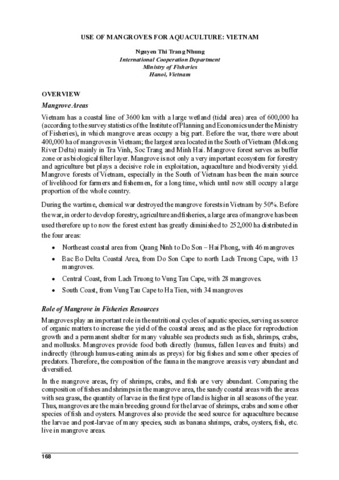Use of mangroves for aquaculture: Vietnam.
| dc.contributor.author | Nhung, Nguyen Thi Trang | |
| dc.date.accessioned | 2012-04-24T08:37:48Z | |
| dc.date.available | 2012-04-24T08:37:48Z | |
| dc.date.issued | 2004 | |
| dc.identifier.citation | Nhung, N.T.T. (2004). Use of mangroves for aquaculture: Vietnam. In: Promotion of mangrove-friendly shrimp aquaculture in Southeast Asia (pp. 168-171). Tigbauan, Iloilo, Philippines: Aquaculture Department, Southeast Asian Fisheries Development Center. | en |
| dc.identifier.uri | http://hdl.handle.net/10862/970 | |
| dc.description.abstract | Vietnam has a coastal line of 3600 km with a large wetland (tidal area) area of 600,000 ha (according to the survey statistics of the Institute of Planning and Economics under the Ministry of Fisheries), in which mangrove areas occupy a big part. Before the war, there were about 400,000 ha of mangroves in Vietnam; the largest area located in the South of Vietnam (Mekong River Delta) mainly in Tra Vinh, Soc Trang and Minh Hai. Mangrove forest serves as buffer zone or as biological filter layer. Mangrove is not only a very important ecosystem for forestry and agriculture but plays a decisive role in exploitation, aquaculture and biodiversity yield. Mangrove forests of Vietnam, especially in the South of Vietnam has been the main source of livelihood for farmers and fishermen, for a long time, which until now still occupy a large proportion of the whole country. | en |
| dc.language.iso | en | en |
| dc.publisher | Aquaculture Department, Southeast Asian Fisheries Development Center | en |
| dc.subject | Viet Nam | en |
| dc.title | Use of mangroves for aquaculture: Vietnam. | en |
| dc.type | Meeting report | en |
| dc.subject.asfa | environmental protection | en |
| dc.subject.asfa | environmental impact | en |
| dc.subject.asfa | nature conservation | en |
| dc.subject.asfa | resource management | en |
| dc.subject.asfa | mangroves | en |


